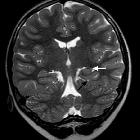Incomplete hippocampal inversion


Incomplete hippocampal inversion describes the situation where the normal inversion of the hippocampus fails to happen during development.
Terminology
Incomplete hippocampal inversion is the most correct description of this finding. Hippocampal malrotation is a term used by some authors although this is not the best description of the embryological events that lead to the appearance of the hippocampus .
Other terms previously used to refer to this appearances have been abnormal hippocampal formation and developmental change of hippocampal formation .
Pathology
Incomplete hippocampal inversion is an anatomic pattern whereby the hippocampus is more rounded, vertical and medially positioned than normal. It is often accompanied by a deep collateral sulcus.
Radiographic features
MRI
It is the constellation of:
- incomplete inversion of the hippocampus with an abnormally round shape
- unilateral involvement of the whole hippocampus is extremely rare and almost exclusively right-sided
- normal hippocampal signal intensity and size
- blurred hippocampal internal structure
- abnormal angle of the collateral sulcus; normal collateral sulcus angle is flat at the level of the body and tail of the hippocampus, and more vertical in cases of hippocampal malrotation
- abnormal position and size of the fornix; normally symmetrical, the fornix may be inferiorly displaced in patients with hippocampal malrotation; however, a low fornix can also be seen in subjects without seizures and without hippocampal malrotation, suggesting that it may be an incidental finding
- normal size of the temporal lobe
- enlargement and particular configuration of the temporal horn seen with agenesis of the corpus callosum but with a normal corpus callosum
The full constellation is reportedly not present in patients without seizures, while others have found no causality between temporal lobe epilepsy and hippocampal malrotation. It has been suggested that hippocampal malrotation is a common variant that can be a sign of disturbed cerebral development , which in turn may affect other parts of the brain, leading to epilepsy. Indeed, just like mesial temporal sclerosis, hippocampal malrotation is uncommon in people without seizures and should elevate suspicion for an underlying epileptogenic disorder .
Siehe auch:

 Assoziationen und Differentialdiagnosen zu Malrotation Hippocampus:
Assoziationen und Differentialdiagnosen zu Malrotation Hippocampus:

